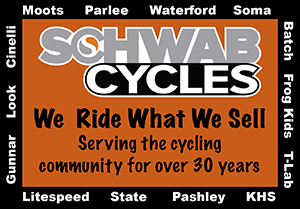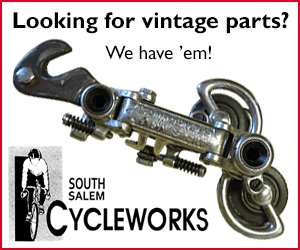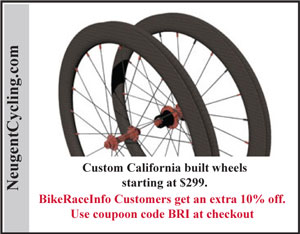Starting a Bike or Any Other Kind of Business from Home
Part Two: Infrastructure
by John Neugent
Tech articles | Commentary articles | Starting a Business Part 1 | Starting a business Part 3 | Starting a Business Part 4
John Neugent probably knows more about bicycle wheels than anyone else alive. Maybe more about bikes as well. He's spent his life in the bike business, at every level. He now owns Neugent Cycling, a firm devoted to delivering world-class equipment at the lowest possible price. If you are in the market for a set of wheels, please, check out John's site. He really knows his stuff. —Chairman Bill

Author John Neugent

Infrastructure for a new business includes everything: business software, office and warehouse space, shipping, and, in some cases, importing.
Business software can be as simple or complex as you want to make it. It’s available very inexpensively for basic systems and the prices go up based on how fancy it is how easy it is to integrate it. For the last 20 years I have been doing all of the accounting and order process myself without any outside help (other than for taxes). It’s really helpful if you understand the basic nuts and bolts of accounting. You should understand what an income statement and balance sheet are but not necessarily how debits and credits work. If you need it, I would definitely get a book on basic accounting.
In the days before computers I was partners in a bike shop and did “the books.” Back then the only thing I cared about was cash flow which, simply asks “do I have enough money to pay the bills.” This has worked for thousands of years. You do a year-end inventory and calculate its value and add up all of your expenses and pay and with those three numbers you can calculate your profit. I also strongly suggest you focus on profit margin which is your gross profit divided by sales. If you sell an item for $1 that costs 60 cents you make a gross profit of 40 cents with a gross profit of 40%. Most bike shops have an average gross profit margin of around 40% but profits of brands and other retailers vary widely. Gross margins for Walmart and Costco are generally in the 20% range. So unless you are as big as Walmart or Costco, I would look for profit margins much higher than 20%.
You will also need a merchant account. This is an intermediary who processes your credit card charges. They charge 2-3% for smaller companies and deposit the money directly into your bank account in 2-3 days. I would suggest you also use PayPal. Their charges are in the same range and many people prefer to pay with PayPal.
Product Liability Insurance is something you will also eventually need. Many shows won’t let you display without it. It can be extremely expensive if you are branding your own products, in the 5% range. If you are reselling other brands there is a good chance you will pay a lot less since they will have the insurance already. This brings up the topic of incorporating. The major advantage of incorporating is it acts as its own entity, separate from you, thereby limiting your personal assets from a liability claim. Incorporating doesn’t require a lawyer. I incorporated in the state of California using a Nolo book on incorporation that included all of the forms and gave simple and clear instructions. Note that I am not a lawyer so I would recommend legal advice on this topic since, I am sure, there are many pitfalls to be avoided. Luckily, liability claims are pretty rare.
Office and warehouse space give you many options. The first and easiest is to operate from your house. If you are not manufacturing something it’s possible to use a fulfillment house to store and ship your products. Fulfillment houses vary widely but they receive the products you order and store and ship them when you send them orders. I understand that Amazon does this but am not sure if Amazon makes the decision as to whether they will store them or not.
Shipping is very straight forward. You can get an account with UPS or Fedex for nothing. I use a service for USPS that allows me to calculate and print postage. There are also freight consolidators that offer UPS and Fedex shipping at a discount. Shipping can be a large cost so it’s worth it to pay attention to it and always look for better deals.
Lastly, dealing with importing. If you are importing in any volume you may need a broker. They are relatively easy to find and generally do a good job. They will handle all of the paperwork for importing and clear the merchandise through customs and arrange to have it shipped to you from the port of entry. They most likely will tell you the tariff number your goods are classified for US Customs. If you have smaller quantities and especially if they are light and small you may want to have the goods shipped through the mail or UPS or Fedex. Be aware that if you use UPS or Fedex, they will tell customs the tariff number and if they are wrong you may end up paying a much higher tariff. This happened to me with Fedex and I contacted them for extra charges in excess of $600 for one order and at the end they did nothing, so I generally use the mail.
All of this may seem to be somewhat daunting but once you get involved with it, it’s pretty simple. In part three I will get into sourcing, and I think that is the most enjoyable part of business.
John Neugent was was one of the first to establish quality hand building in Taiwan around the turn of the century. He now owns Neugent Cycling, a firm devoted to delivering world-class equipment at the lowest possible price.









